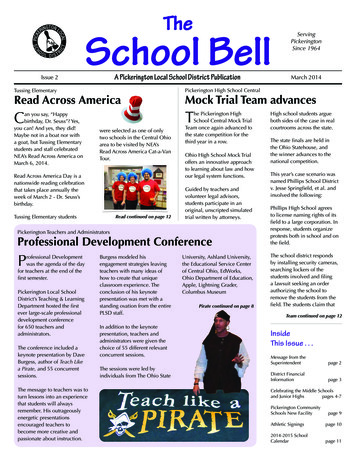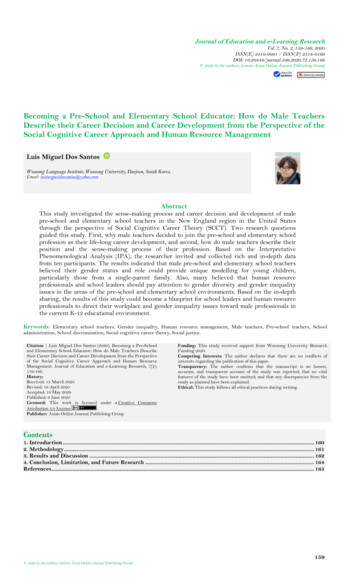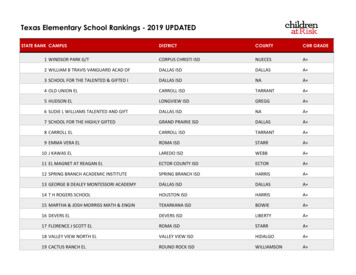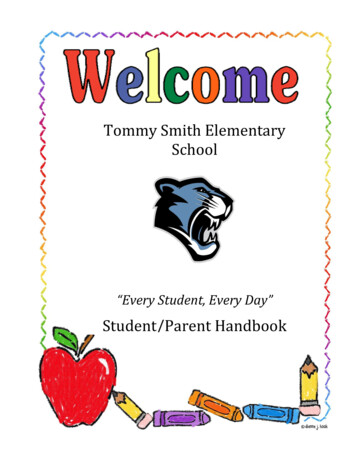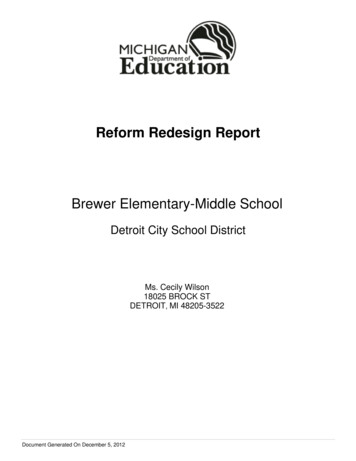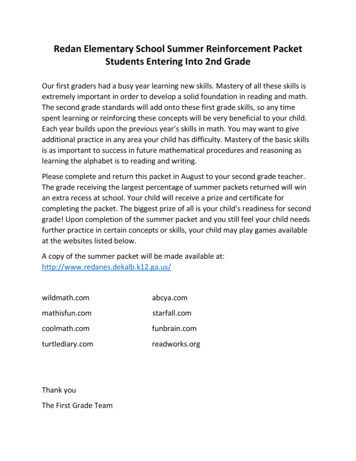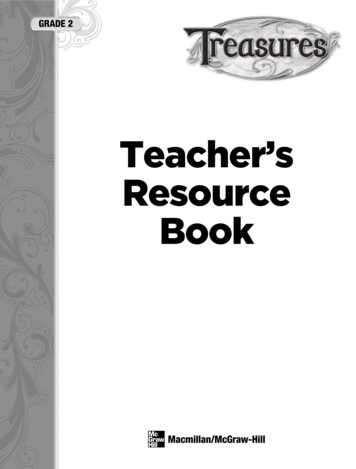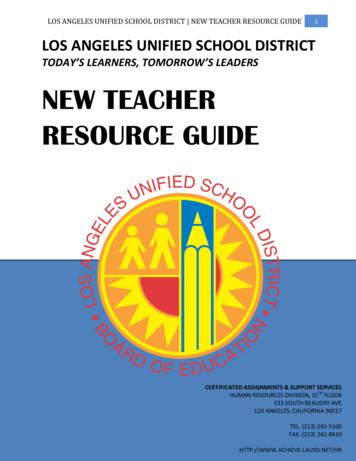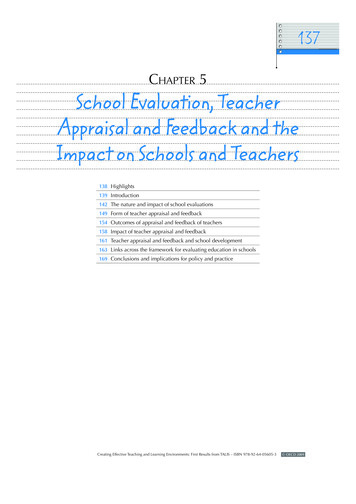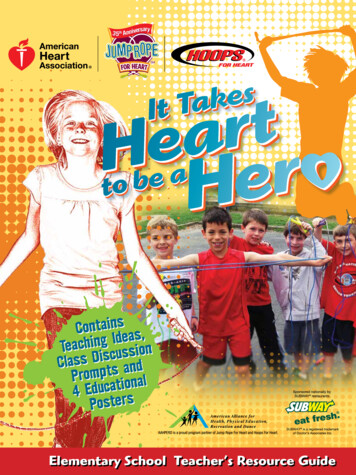
Transcription
rsary3 5th AnniverContains s,eadIgnihcTeanoissucsC las s D i s a n dPrompt naliotacudE4PostersElementary School Teacher’s Resource Guide
teacher’s GuideThe Heart and How It WorksThe language and activities in this guide can be used as a tool to teach students how the heart works, whyit is important to keep the heart healthy and how to be heart-healthy for life.from the left ventriclethrough the aorta toall parts of the bodyfrom the right ventriclethrough the pulmonaryartery to the lungs6aortapulmonaryartery3leftatrium4from thebody into theright atrium1rightatriumfrom the lungs intothe left atriumleftventriclerightventricle52from the right atriuminto the right ventricle2f rom the leftatrium into theleft ventricle
teacher’s GuideYour Amazing HeartYour heart is an amazing muscle. It is only about the size of your fist and beats many millions of times in your life. Your heartgrows with you, and it can continue to strengthen even after the rest of your body has finished growing.Your amazing heart pumps about 2,000 gallons of blood through 60,000 miles of blood vessels every day!How the Heart WorksWithout oxygen, the body cannot survive. When you breathe, oxygen is taken in through the lungs and transferred to theblood. This freshly oxygenated blood travels from the lungs to the heart, where it is pumped through all of the arteries inthe body, bringing fresh oxygen to your muscles and organs. When the blood runs out of oxygen, it returns to the heart tobe pumped back into the lungs and refilled with oxygen. This incredible process carried out by the cardiovascular systemkeeps all body systems functioning in harmony.In the cardiovascular system, the heart and lungs work together to pump blood and nutrients throughout the body througharteries. When the blood is empty of oxygen, it returns to the heart through the veins.When the heart pumps, it makes a sound like a drum. This is your heartbeat, or pulse. Unlike other muscles in your body,your heart is an involuntary muscle. It contracts on its own without any effort on your part.Your heart is similar to a two-story house with four rooms: two rooms on the top floor and two rooms on the bottomfloor. Each room is called a chamber. The right atrium and left atrium are the upper chambers. The right ventricle and leftventricle are the lower chambers.The right atrium receives the blood from the body that is low in oxygen and pumps it into the right ventricle. The rightventricle then pumps the blood through the pulmonary artery to the lungs to receive oxygen.Newly oxygenated blood is sent back from the lungs to the heart, this time to the left atrium where it is then pumped intothe left ventricle. The oxygen-rich blood is then pumped out through the aorta to the entire body.The heart also has valves that control the direction of blood flow. Think of these valves as doors between the rooms that openand close to let blood in or stop it from entering. The “thump-thump” you hear when you listen to the heartbeat is the soundof the valves closing.Vocabulary Definitions Cardio: Refers to anything that has to do with the heart. Vascular: Refers to anything that has to do with the body’snetwork of blood vessels (veins, arteries and capillaries). Cardiovascular system: The network of the heart, lungsand blood vessels that delivers blood throughout the body. Heart Chambers: The four, hollow sections of the heartthat receive and distribute blood. Atria (singular: atrium): The two upper chambers ofthe heart that receive blood. Ventricles: The two lower chambers of the heart thatdistribute blood. Heart Valves: The four doors between the heartchambers that open and close to let the blood flow inonly one direction. Aorta: As the freeway for oxygenated blood, the aortais the main artery that disseminates oxygen-rich bloodfrom the heart to the body. Pulmonary Artery: The pathway that “used” blood(blood low in oxygen) takes from the heart to the lungsto be refreshed with oxygen.Did You Know? The human heart beats an average of 72 times per minute. Over an average lifetime, the heart beats about 2.5 BILLION times! During exercise, blood travels from your heart to your big toe and back again in only 10 seconds. Y our amazing heart loves it when you laugh. A good laugh sends 20 percent more blood through your body!Special HeartsSome people are born with hearts that are formed differently. People with these special hearts often require help fromdoctors. The term congenital heart defect is used to describe these heart ailments. A congenital heart defect is not a disease.It is a malformation of the heart that prevents the heart from functioning normally.3
teacher’s GuideActivityActivity: Heart Obstacle CourseSource: Denise Douglas, physical educator at Parkland Elementary School, Yukon, OklahomaLearning Expectations: Students will learn the names of the parts of the heart and how each area of the heart functions in theprocess of oxygen exchange.Equipment Requirements: Red and blue gym floor tape Balance beam Red and blue hula hoops Red and blue balls Hula hoop holders Two buckets Tumbling mats Labels of parts of the heart Scooters MusicStandards: This activity meets NASPE Standards 1, 2, 3 and 4.Introductory Activity: Discuss key vocabulary terms, such as arteries, veins, capillaries, oxygen, lungs, left atrium, right atrium,left ventricle, right ventricle, aorta and heart valve. Discuss how the heart transports blood to the lungs and throughout the body.Directions: Using the red and blue gym floor tape, tape a large heart that fills the entire gym. Use red hula hoops that stand vertically for arteries and vertical blue hula hoops for veins. Tape arrows on the floor to provide direction for the children. Make labels for the different parts of the heart and attach them to hoops or cones as needed. Place 20 red balls to represent the oxygenated blood in a bucket at the lungs, and 20 blue balls to representdeoxygenated blood in a bucket at the area between the red and blue capillaries. Within each chamber of the heart, place equipment for a physical activity that can be done while the child is in that chamber.Examples include a mat to do log rolls, hopscotch, a balance beam, or a scooter to ride around a designated path.Play begins in the “lungs.” The students pick up a red ball (oxygenated blood) while standing in the lungs and take a deepbreath. They follow the arrows that lead them into the left atrium. They perform hopscotch while in the left atrium. They mustnow crawl through an obstacle that is labeled the mitral valve.They are now in the left ventricle. Students ride a scooter aroundan arrowed path while in the left ventricle and follow the arrowto the aortic valve into the aorta. Students follow the arrowsaround the outside of the heart and make their way through thevertical hula hoops that serve as the arteries, arterioles and smallcapillaries. In the capillaries, a gas exchange takes place andstudents leave the red ball in the box. Students take an exercisecard out of the exercise bucket and perform the exercise.4
teacher’s GuideStudents then pick up a blue ball from the boxand crawl through the blue capillaries and veinsuntil they get to the top of the “heart.” Studentsenter the heart through a hoop labeled the venacava (this is where all blood enters the heart).Students are now in the right atrium. They lieon the mat and perform a log roll down themat while holding onto the blue deoxygenatedball. They crawl through the tricuspid valve intothe right ventricle. While in the right ventricle,they walk balance beams that are placed in theshape of a V. Students then travel through thepulmonary valve, then through the pulmonaryartery and back into the lungs, where theprocess begins again. Students place thedeoxygenated blue ball in the box as they exhaleand pick up an oxygenated red ball to begin thetrip again.Discussion: Give students a simple diagram of the heart and ask them to label the four chambers of the heart. Older studentscan show the flow of blood through the heart and label the different valves.LungsRed BallsStartVeinsArteriesCapillariesCapillariesTask Cards Blue Balls5
teacher’s GuideHeart Disease Facts and Warning SignsWhat is Heart Disease and Who’s at Risk?Everyone has heard the term “heart attack,” but what does it mean? The heart pumps blood full of oxygen and other nutrients toall parts of the body, but the heart muscle needs oxygen and nutrients too. The arteries that supply the heart muscle with bloodto keep it working are called coronary arteries. In a healthy person, blood flows freely through the coronary arteries. Over time,unhealthy habits like not getting enough physical activity or not eating a healthy diet can cause them to get clogged.When this happens, fatty deposits called plaque build up inside the artery walls — atherosclerosis. Over time, if enough plaquebuilds up, the arteries — which are normally flexible and elastic — can become hard. Blood flow can become partially or totallyblocked in the coronary arteries supplying the heart muscle. If the heart muscle cannot get the oxygen and nutrients it needs, itstarts to die. This is called a heart attack.Atherosclerosis and the damage a heart attack causes to the heart, are some of the conditions referred to as heart disease. Severalfactors can increase the risk for heart disease, but the good news is that some of these factors are within your control. If you eatright, exercise and stay tobacco-free, your heart will thank you. The most important thing you can do is to start now because itwill be a lot easier to form heart-healthy habits for life if you start at a young age.Here’s what you need to know to reduce your risk: Know your history: Some types of heart disease are genetic, which means people have an increased risk of heartdisease if their immediate family members have had heart disease. Ask your parents if someone in your family hashad heart disease. If you have with a family history of heart disease, it’s even more important that you strive to livea heart-healthy life. Stay tobacco-free: Nicotine, the addictive chemical in cigarettes, makes your heart rate and blood pressure rise. The carbonmonoxide in cigarettes also makes it difficult for your heart to get the oxygen it needs to function properly. Smoking isresponsible for 443,000 premature deaths each year, with about one-third of those deaths linked to heart disease. But smokersaren’t the only ones at risk: Secondhand smoke exposure causes roughly 49,000 smoking-related deaths each year. Get enough exercise: Obesity, or being 20 percentheavier than the ideal body weight for your height,means the body must work harder to support theextra weight. Over time, this can strain the heartand increase the risk of high cholesterol and diabetes.Exercise helps keep your body at a healthy weightand reduces the risk of heart disease. E at a healthy diet: Fruits and vegetables containnutrients your body needs, and they taste great too!Eat heart-healthy by limiting foods high in sodiumand sugar and eating a variety of fruits, vegetablesand whole grains every day.Did You Know? Nearly 84 million American adults — that’s aboutone in three people — have at least one type ofcardiovascular disease. About every 34 seconds, someone in the United States has a heart attack. Smoking increases the risk of heart disease by two to four times. Major risk factors for heart disease include tobacco use, poor diet,physical inactivity, genetics, obesity, high blood pressure, highcholesterol and diabetes.6
teacher’s GuideActivityActivity: Risk Factor TagSource: Mike Lowery, physical educator at Cedar Ridge Elementary School in Lowgap, N.C. and Chad Triolet, physical educatorat Deep Creek Elementary School in Deep Creek, Virginia.Learning Expectations: Students will understand the risk factors for heart disease and heart attack.Equipment Requirements: Six pool noodles of different colors Six cones of the same color Six color-coded risk factor task cardsStandards: This activity meets NASPE Standards 1, 2 and 5.Introductory Activity: Discuss the importance of knowing the primary risk factors for heart disease: obesity, high bloodpressure, diabetes, inactivity, smoking and high cholesterol. You can use the acronym OH DISH to help students remember thesix major risk factors.Directions: The objective of the game is to avoid the risk factors for heart disease represented by the different colored poolnoodles. Each noodle represents a different risk factor. If a student is tagged with a noodle, she or he will go to the color conethat matches the color of the noodle and perform the activity on the risk factor task card at that station. The person who is thetagger must drop the noodle after tagging another person. If a risk factor noodle is on the floor, any student who has not beentagged may pick it up and become a tagger. For safety, students must stay on their feet except when performing the risk factortask exercises and players must stay inside the boundary lines designated by the cones.Discussion: Discuss the risk factors for heart disease using the mnemonic device OH DISH. Ask students to identify which colornoodle represents each risk factor.Common Symptoms of a Heart AttackHow do you know if someone is having a heart attack? Many symptoms of a heart attack are easy to recognize, but the warningsigns often vary between men and women. And not everyone experiences chest pain with a heart attack. If someone you knowexperiences the following symptoms, they may be having a heart attack: Chest pain or discomfort Pain or discomfort in one or both arms, the back, neck, jaw or abdomen Shortness of breath Nausea Cold sweats LightheadednessWhat Should You Do if Someone You Are With Has a Heart Attack?Get help from an adult right away if someone you are with believes they are having a heart attack. If there are no other adultsaround, call 9-1-1 immediately.Emergency medical services (EMS) arrive within minutes to begin life-saving treatment. Learning what to expect when you call9-1-1 can help you save a life: Try to stay as calm as possible. Speak slowly and loudly. Know your location: What is the address? Is there an adult nearby who can help you if you don’t know? Do you know the name of the person who is sick? If so, tell the 9-1-1 call taker. Know your phone number: Do you know the telephone number of the phone you are calling from? Is the person who is experiencing heart attack symptoms awake and focused? Can they talk? Stay on the phone with the emergency services provider until the ambulance arrives. Remember, 9-1-1 is for emergencies only. Never call 9-1-1 as a joke.7
teacher’s GuideActivitiesActivity: Veins and ArteriesSource: Mehrhof, J.H., Ermler, K., Worrell, V. and Brewer, J. (2007). Never Play Leapfrog with a Unicorn. Reston, VA: NationalAssociation for Sport and Physical EducationLearning Expectations: Students will be able to recognize common risk factors for heart disease.Equipment Requirements: NoneStandards: This activity meets NASPE Standards 1 and 4.Introductory Activity: Discuss the risk factors for heart disease (obesity, poor diet, high blood pressure, tobacco use, physicalinactivity, etc.) and how blockages in the veins and arteries can lead to heart attack or stroke.Directions: Tell the students that the gym is the body and that lines on the gym floor are the veins and arteries. Assign severalstudents to be taggers. The taggers represent risk factors for heart disease. The other students will walk along the veins andarteries and try not to get tagged. Taggers may move freely around the gym.Instruct students, including the taggers, to move at a fast walk. When a student is tagged, he or she becomes a “blockage” inthe vein or artery. The blockages must put themselves in an inverted “V” position for a count of 20 (or other appropriate time)and then return to the game. If students who are still moving come to a blockage, they must crawl under the blockage (i.e., theinverted “V”) to continue. Switch taggers after a set amount of time.Discussion: Was it harder to move around or under a “blockage”? Explain that when there is fat in the arteries, the heart mustalso work harder to move blood around the blockage. This could contribute to a heart attack. To stay heart-healthy, instructstudents to avoid as many heart disease risk factors as they can.8
teacher’s GuideActivity: Artery AvengersSource: National Association for Sport and Physical Education (2011). Physical Best Activity Guide: Elementary Level.Champaign, IL: Human Kinetics.Learning Expectations: Students will be able to identify and discuss how too much saturated and trans fat in the diet canincrease cholesterol in the blood and result in placing them at risk for heart disease.Equipment Requirements: Softballs (or yarn balls or paper balls)Hula hoopsConesFrisbeesStandards: This activity meets NASPE Standard 4 and AAHE Standard 1.Introductory Activity: Explain to the students that regular physicalactivity (at least 60 minutes a day for kids) helps to prevent fattycholesterol from building up in the arteries and helps to keep theheart healthy. Red meat, eggs and full fat dairy products are sourcesof saturated fat and cholesterol.Explain how blood flows through our arteries (hoops) and how too muchaccumulated fat (softballs) in the blood can cause plaque to develop inthe arteries and thicken over time. Remind students that physical activityreduces the amount of fat in the blood and keeps the heart healthy.Explain that the more active they are in the game, the less fat (softballs)there will be in their team’s arteries (hoops).Directions: Divide students into two groups. Line up the cones in the middle of a room to divide the room into two halves.Tell students they cannot cross over the line. Place the hula hoops (arteries) in the back of each half of the room. Spread thesoftballs (fat) around the floor.Students toss one softball at a time across the room to the opposing team’s hula hoops, trying to fill their opponent’s hula hoopswith balls. After the balls are in the hoops, students cannot take them out. Balls that do not land in a hula hoop may be pickedup and thrown again. The game continues until you have a good example to begin the discussion with a visual aid.Reset for the second part of the activity.For the second round, select students to act as artery avengers in a ratio of three avengers to six hoops. This ratio shouldprovide some challenge and allow sufficient room for students to move around safely. Artery avengers block the softballs fromentering the hula hoops with a Frisbee, which they should hold like a shield. Tell students that the shields represent physicalactivity that helps keep fat from building up in the blood.Teaching Hints: Be sure to tell the students that our bodies need some fat to help our body carry out normal body functions, buttoo much fat can lead to serious health conditions.If you have colored Frisbees, assign each color a name. For example, green could represent vegetables, blue could representwater and red could represent increased blood flow from exercise.For students with limited mobility, designate a peer helper to help pick up the balls. Place a hula hoop at the center line for thosewho have difficulty throwing or grasping and manipulating objects.Discussion: Ask students to stand by the healthiest artery (the hula hoop with the fewest balls in it). They should identify hoopslargely filled with balls (fats) as unhealthy.9
teacher’s GuideHow to Recognize if Someone is Having a StrokeActivity: F.A.S.T (K–2)Learning Expectations: Students will learn what a stroke is and stroke warning signs and symptoms. Students will engage inphysical activity in order to memorize what F.A.S.T. stands for in a fun and interactive way.Equipment Requirements: F.A.S.T. Posters F.A.S.T. Coloring sheet
Atria (singular: atrium): The two upper chambers of the heart that receive blood. Ventricles: The two lower chambers of the heart that distribute blood. Heart Valves: The four doors between the heart chambers that open and close to let the blood flow in only one directio
